How to Gain All the Benefits Of Gamification In Business Apps?
Updated 16 May 2023
10 Min
4992 Views
When we're chasing new effective business strategies and approaches we sometimes try to reinvent the wheel, making things more difficult. While the situation demands the opposite. Looking at some of the most popular projects we can't help wondering about their simplicity and tenuity. The ability to combine heavy functionality with simple UI is an art. The ability to turn it into a game is gold.
Mobile app gamification is a groundbreaking technique in the arena of mobile application development services. The aim of this article is to explain how gamification influences businesses, what are the main principles of the gamification process and examine the best gamification apps which took this approach as a basis.
Gamification in business apps
Gamification is the process of making something look and feel like a game. People like games, because they are fun. Remember how your mom asked you to eat a bowl of oatmeal and you imagined that it's missile fuel and you are a rocket and will fly to the space after dinner because you hated oatmeal? This is it. In plain English, all you need to do is convert some boring assignments onto a fun game where users don't feel like they are obliged to do that.
The gamification approach can be used in almost any type of application and bring lots of perspectives to it's owner. The gamification elements can be implemented as in customers apps and in in-house solutions for employees only. Both approaches are very productive. If you want to estimate the cost to create an app, decide from the very beginning whether you would add any gamification elements or not because they will influence the functionality and the cost itself. As the leader of a company, you have to understand how gamification and employee engagement work. If you make your in-house app more like a game, you will significantly influence such aspects.
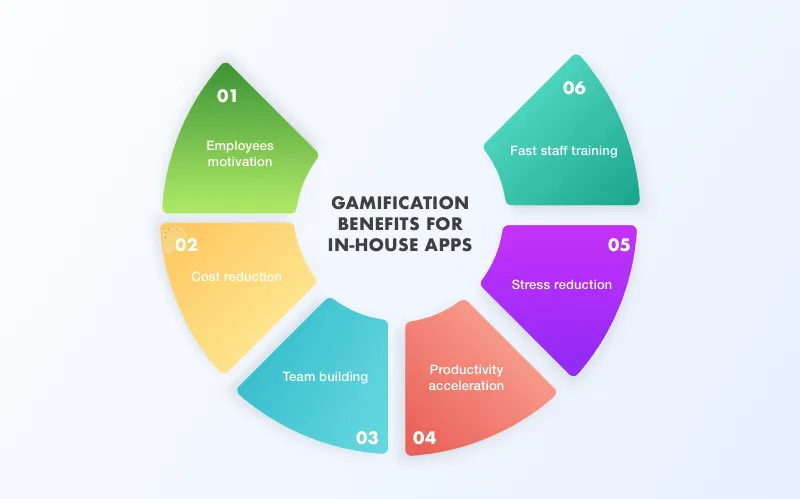
Employee gamification benefits
Employees motivation
In some companies rivalry between managers or departments is encouraged which can lead to various conflicts and disputes. Using gamification for employees approach you will leave the idea but iron out the difficulties. Contests in a game will be considered less seriously than a failure at work.
Cost reduction
Add a step counter into your employees' app and reward a person who walks the most, or eats the healthiest foods. Eventually, you'll see the results. Healthy workers are sick less often.
Team building
The contests between departments usually ruins good fellowship. Combine these departments and set one goal for them. Even if people don't like each other, being on one team will unite them.
Accelerate productivity
Being in a team, feeling the support of the team members magically influences on the productivity. Especially if the goal is clear and the reward is cherished (like bonuses, paid awards or additional days to a vocation).
Reduce stress
Workers react better if the task is set in a game (they feel like it's a game). Here's a simple gamification example, if your sales manager sold 5 cars last month and you told him his plan is 10 cars now, he or she can consider it an impossible task. If the same task will be set in a game, the user sees himself as a player and feels less stressed.
Fast staff training
Gamification for employee training is the other way to reduce costs. Lots of educational platforms apply the gamification approach, so why can't we do the same? New equipment manuals, workplace safety standards or the characteristics of new goods aren't so interesting. But if you add game elements with lots of encouragements and a reward, in the end, you'll be surprised with your employees' results.
Gamification in apps for a wide spectrum of users is beneficial as well. Besides, it can also generate a handsome profit for your business.
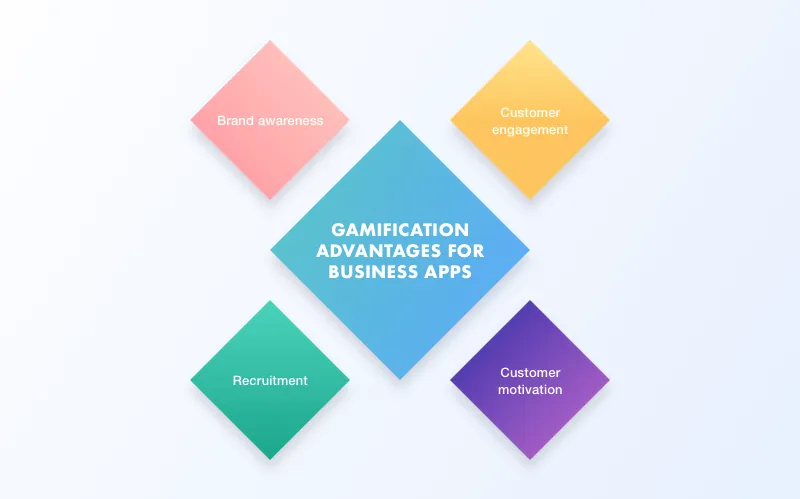
Gamification in business apps
Motivation. It is probably one of the reasons why developers start using gamification of apps. Common users are captivated with the idea of contests and rewarding. If we look at fitness apps, most of them use the principles of gamification. They allow users to set a desirable goal and encourage them to make small steps every day instead of a usual statistics table which just stores the user's results. When a user sees how many days are left to reach their goal or where his friends are in the program, it motivates them.
Brand awareness. The formula is clear. The better and more interesting your app is, the more people will like it and use it and get acquainted with your brand. This is how the gamification techniques work in business.
If you need to promote your app but your budget is limited, learn how to do it for free with our tips!
Customer engagement. You probably have heard that some airlines offer you to join their club, collect miles and then get a nice discount on the flight tickets. They do it because they want you to be a loyal, regular customer of only their company. It is also a game. All discount cards work the same way. If a customer needs to collect points, miles or whatever, he uses the same shop, airline or dry cleaner.
Recruitment. Some educational apps like programming learning apps offer not only tutorials and training materials but also different tests after a course. If a student did very well on the exam he can be offered a position in a development company.
What are the gamification principles?
There are some basic principles of the gamification process, which you have to take into account when planning your app. Missing one of them might lead to failure, so take your time and think about them carefully.
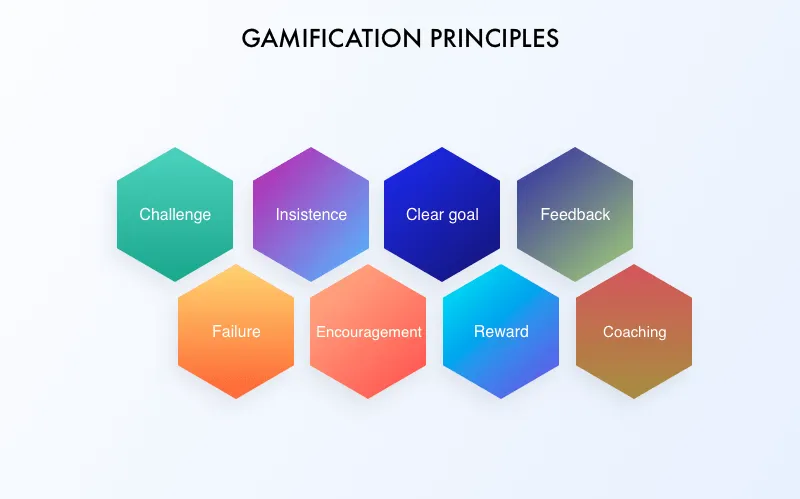
Gamification best practices
Challenge
The first and main task is to invite a user to participate in a contest, with a system or other users. The application should set a very clear task (challenge) for the customer with clear rules and terms of it's fulfilment. It's very important here to make the conditions and rules clear and transparent. If they seem too complicated, users will quit immediately.
Failures
If there is a game - one will win and the other will lose. However, a user should have an opportunity to start over, to have more than one chance. Under such conditions, users would want to try again, maybe even more zealous.
Insistence
Offer users the chance to play again (go back to your app) with any available ways. It can be a push-notification, reminders or even alerts. The more you ping a person, the more often he opens your application and uses it.
Encouragement
Encourage users every time they fail. It can be a simple phrase not to give up but to continue, maybe a quote from a famous person. All these have to excite customers and make them want to try once more.
Clear goal
It's the aim of the game. Don't let users forget about it. You can give them a chance to set a goal by themselves. All you need to do is to show it from time to time. Encouraging won't work if a user forgot why he or she is doing all that, or if the aim is inconspicuous and doesn't attract a customer.
Rewards
Rewards are needed as a logical conclusion to the whole process. It can be either a real or a virtual prize or just a Champion Emeritus. What matters here is the desirability of the reward. It has to be something significant.
Feedback
In some cases, a user doesn't understand what is going on or what is going to happen next. Feedback is a fundamental part of any game so the user knows exactly why he failed or won. Almost any interaction with a system should be commented with feedback.
Coaching
Make it optional. Some customers need guidelines and some don't. For those who are doing it for the first time, you have to add small tips so the user doesn't close your app the second he felt confused.
I hope the rules of gamification in mobile apps are clear. Let's talk about the ways and methods we are going to implement gamification into our business app. You can literally use anything that springs to your mind to engage and encourage your customers. Here are some of the hacks to use to make your app very interactive:
- Virtual money. Despite the fact that it is actually virtual, people tend to like it and would like to do some tasks to gain it. Yet, Virtual money can only act as encouragement, not as a reward.
- Push notifications can be used to remind users of the app or a challenge there. For example, a notification can inform that the competitor scored lots of points and is now close to you.
- Status. The most simple division is - beginner- master- pro. There can be more statuses to encourage and captivate customers. Users like getting new status especially if they play against real people (not the system).
- Tips. As we have already mentioned, this feature has to be optional, because it usually annoys seasoned users, but, for greens it is necessary.
Common gamification problems and mistakes
The mobile app gamification approach gives you a huge opportunity to accelerate your business. It doesn't take a long time to develop these features and the cost is rather low. However, there are some pitfalls which can bring the opposite result. Here are the most important don'ts to take into consideration while you develop an app for iPhone or Android:
First. Don't make it compulsory. Give a user the chance to choose whether he needs gamification features or not. If your target audience is middle-aged customers, make it optional, because some users (if not a vast majority of them) would find such an approach juvenile.
Second. Don't concentrate on a competition. The app has to engage and motivate but not to promote a fight. Emphasizing the wrong element can shift the user's attention from your brand and your business to secondary things.
Third. Don't give rewards for just anything. A reward should be a tough thing to achieve. If it's too easy to get, no one values it. And vice versa, too lofty aims persuades users that it's not even worth trying.
Fourth. Don't blur a goal. It has to be very clear. Users need to understand what steps to take to achieve it. If he doesn't, he won't go for it.
Best examples of gamification in apps
The gamification app examples we are going to list have avoided pitfalls and made perfect products that give lots of joy to their customers. They applied gamification methods for a variety of reasons, but they did it properly and it delivered lots of benefits.
Habitica - is an app which helps you perform daily, routine tasks better and faster. The program creates your avatar which improves with every task done. After you have levelled up your avatar, you can fight monsters or even your friends' avatars.
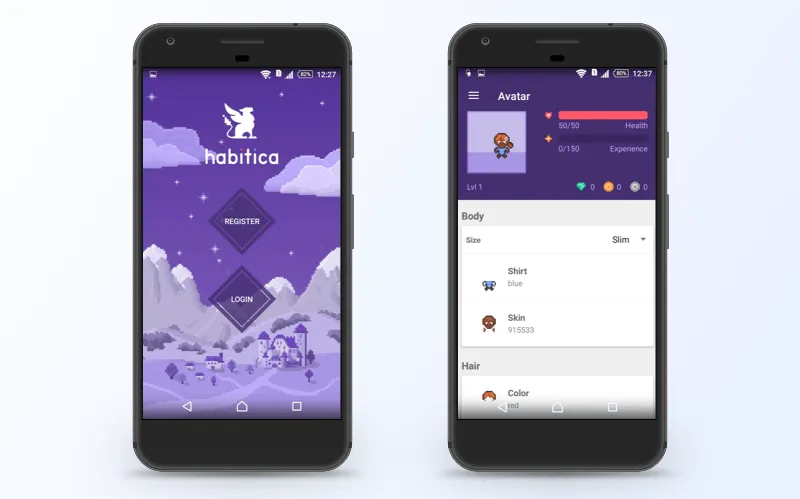
Habitica - screenshots
Telfie - is an entertainment social network that engages new users with free tickets and bonuses if they register and share what they are currently reading or watching. Interacting with the system, you train the recommendation engine so it offers you films, books or music according to your preferences.
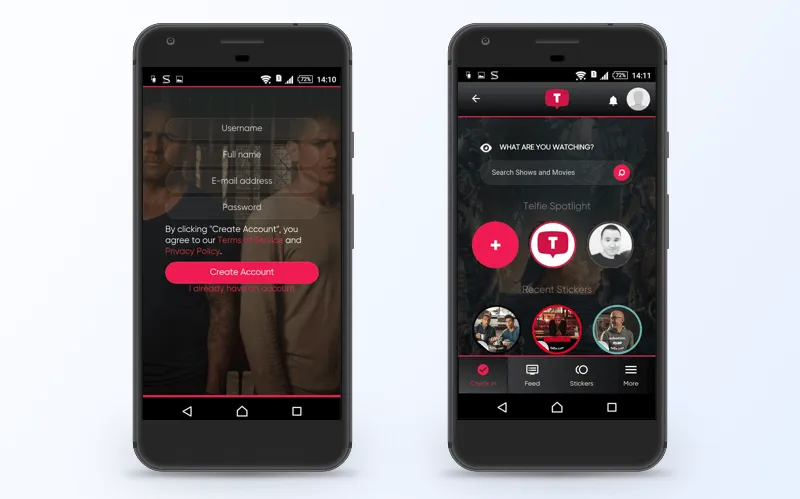
Telfie - screenshots
Zombies, run! - is an amusing fitness app for runners. While running, you are listening to a recording of zombies that are following you. Gamification here captivates the user so he or she doesn't think about miles or how hard running is. With this app, exercising is a fun game.
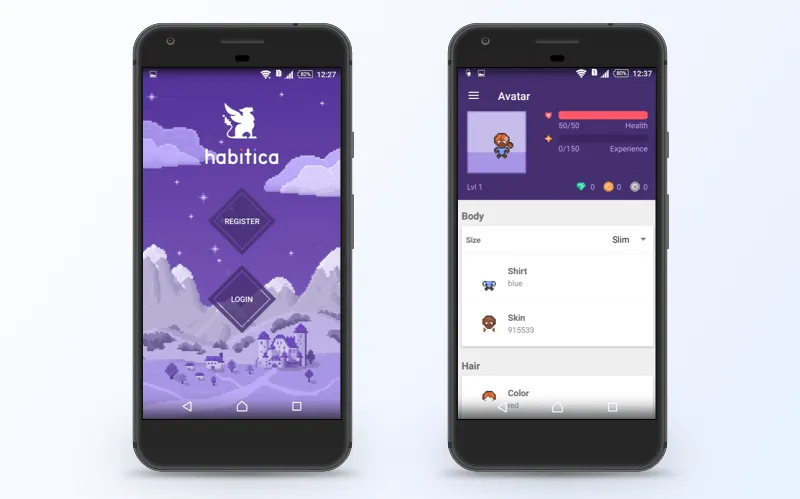
Zombies, run! - screenshots
It's not difficult to create your own fitness app if you learn our tutorial first!
Gamification is a perfect approach to make your app recognisable. The approach offers you freedom of selection. You can choose the methods that you like and think are the best for your app. The whole app may be in the form of a game or just a few elements which you would add to refresh an old project. Still, don't forget the pitfalls you need to avoid and issues you need to think over in order to develop a really interesting app, not an annoying one. Consider the target audience and what they need. If you do so, you'll improve your productivity and not only that. Companies that use gamification in their apps proved that it really works! To apply gamification into your project contact our managers and well build a perfect strategy for you!
If you want to develop a really nice looking, engaging fitness app then you need to watch our tutorial video about it. Don't forget to subscribe to our channel to keep abreast of the development trends and innovations.

Evgeniy Altynpara is a CTO and member of the Forbes Councils’ community of tech professionals. He is an expert in software development and technological entrepreneurship and has 10+years of experience in digital transformation consulting in Healthcare, FinTech, Supply Chain and Logistics
Give us your impressions about this article
Give us your impressions about this article